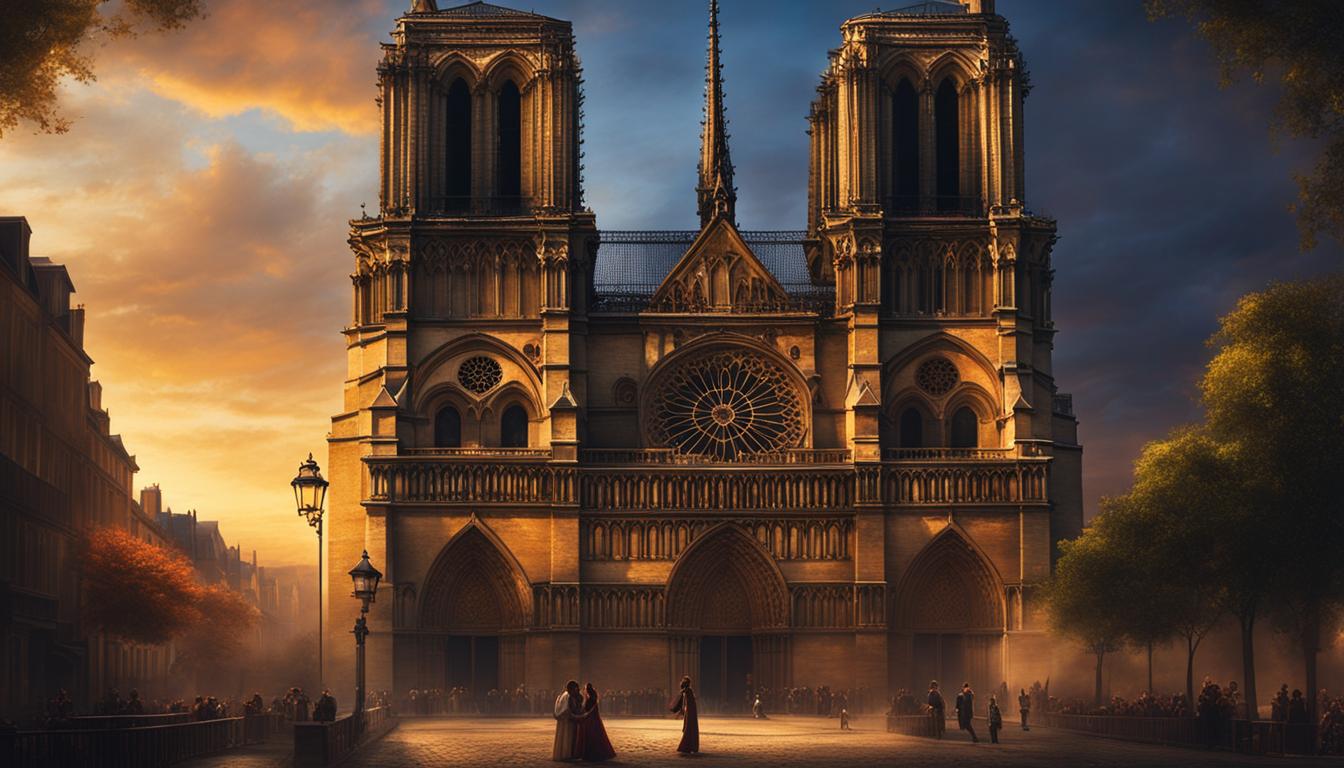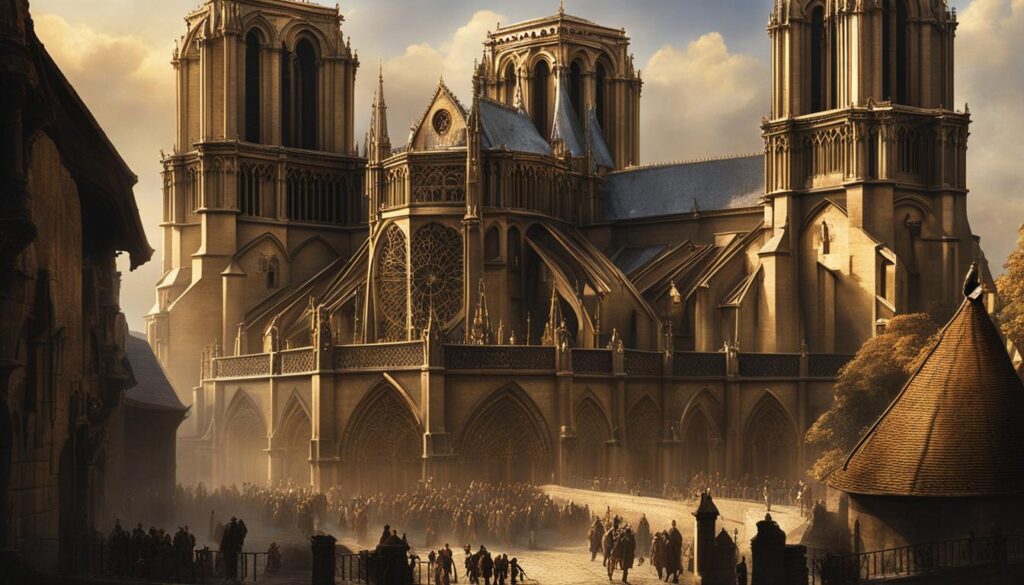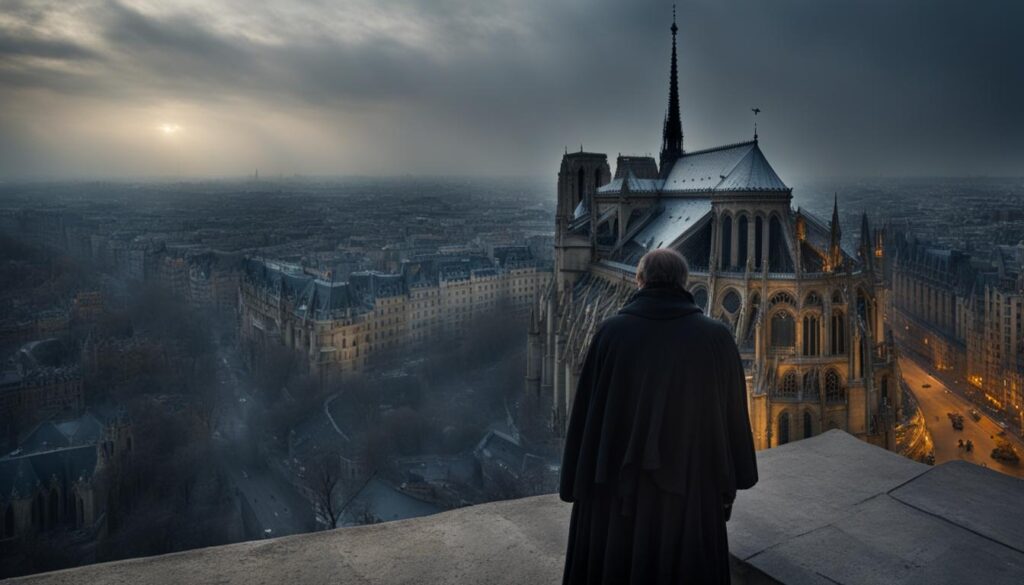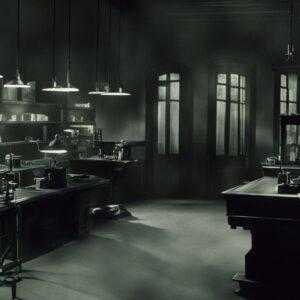As a film enthusiast, I am always on the lookout for classic movies that have stood the test of time. One such timeless masterpiece is The Hunchback of Notre Dame (1939). Based on Victor Hugo’s beloved novel, this classic film takes viewers on a captivating journey through the streets of Paris, showcasing the mesmerizing Gothic architecture of Notre Dame Cathedral.
The heart of the story lies in the tragic love affair between Quasimodo, a deformed bell-ringer, and Esmeralda, a captivating young gypsy woman. Their forbidden love unfolds against the backdrop of a historical drama, immersing viewers in a world of passion, prejudice, and redemption.
With its gripping narrative and powerful performances, The Hunchback of Notre Dame (1939) continues to captivate audiences even after more than eight decades. Its exploration of universal themes and its visual splendor make it a true cinematic marvel that deserves to be experienced by film enthusiasts and lovers of classic movies.
Key Takeaways:
- The Hunchback of Notre Dame (1939) is a classic movie based on Victor Hugo’s novel.
- It showcases the stunning Gothic architecture of Notre Dame Cathedral in Paris.
- The film tells a tragic love story between Quasimodo and Esmeralda.
- It is a historical drama that explores themes of love, prejudice, and redemption.
- The Hunchback of Notre Dame (1939) continues to captivate audiences with its timeless tale.
The Story of The Hunchback of Notre Dame (1939)
The Hunchback of Notre Dame (1939) is a captivating film that brings Victor Hugo’s beloved story to the silver screen. Set in 15th-century Paris, the movie tells the tragic tale of Quasimodo, a deformed man who resides in the bell tower of Notre Dame Cathedral. The storyline revolves around Quasimodo’s love for Esmeralda, a beautiful gypsy girl, and the obstacles they face in their quest for happiness.
The plot of The Hunchback of Notre Dame (1939) is filled with love, betrayal, and redemption. Quasimodo, known as the Hunchback, falls in love with Esmeralda at first sight. However, their love is threatened by the villainous Claude Frollo, the Archdeacon of Notre Dame, who harbors a sinister obsession with Esmeralda. As the story unfolds, Quasimodo must navigate a treacherous world filled with prejudice, injustice, and societal expectations.
The film’s storyline beautifully captures the essence of Victor Hugo’s novel, exploring themes of love, acceptance, and the power of inner beauty. It delves into the complexities of human nature, highlighting the struggle between good and evil within each character. The emotional journey of Quasimodo and Esmeralda, as they battle against societal norms and personal demons, resonates with audiences and leaves a lasting impact.
Quasimodo: “Why was I not made of stone, like thee?”
The Storyline Overview
| Act | Events |
|---|---|
| Act 1 | Introduces Quasimodo, Esmeralda, and Claude Frollo. Quasimodo falls in love with Esmeralda and befriends her. |
| Act 2 | Frollo’s sinister obsession with Esmeralda grows, leading to Quasimodo’s desperate attempts to protect her. The city’s judgmental society further isolates Quasimodo. |
| Act 3 | Esmeralda is falsely accused of a crime and faces execution. Quasimodo rescues her and takes her to the safety of the cathedral. Frollo’s true intentions are revealed. |
| Act 4 | The city erupts into chaos as Quasimodo fights to save Esmeralda and confront Frollo. The story reaches its tragic climax with a bittersweet ending. |
The Hunchback of Notre Dame (1939) presents a compelling storyline that showcases the power of love, the destructive nature of obsession, and the triumph of the human spirit. Through its memorable characters and emotional narrative, the film continues to captivate audiences and remains a timeless classic.
The Cast and Characters of The Hunchback of Notre Dame (1939)
In the 1939 film adaptation of The Hunchback of Notre Dame, a talented cast brought the beloved characters to life with their captivating performances. Charles Laughton portrayed the iconic role of Quasimodo, the deformed bell-ringer with a heart of gold. Laughton’s portrayal captured the complexity and humanity of the character, evoking empathy and admiration from the audience.
Maureen O’Hara portrayed the enchanting Esmeralda, the beautiful gypsy girl who captures the hearts of both Quasimodo and Claude Frollo. O’Hara’s portrayal added depth and charm to the character, showcasing her strength and resilience in the face of adversity.
Sir Cedric Hardwicke delivered a powerful performance as Claude Frollo, the morally conflicted antagonist. Hardwicke skillfully portrayed Frollo’s internal struggle between his desire for Esmeralda and his religious beliefs, bringing complexity and depth to the character.
| Cast | Character |
|---|---|
| Charles Laughton | Quasimodo |
| Maureen O’Hara | Esmeralda |
| Sir Cedric Hardwicke | Claude Frollo |
| Thomas Mitchell | Clopin |
| Edmond O’Brien | Gringoire |
The supporting cast of The Hunchback of Notre Dame also included notable actors such as Thomas Mitchell as Clopin, the King of the Beggars, and Edmond O’Brien as Gringoire, a poet and playwright. Their performances added depth and nuance to the film, enhancing the overall cinematic experience.
The talented cast of The Hunchback of Notre Dame (1939) brought Victor Hugo’s beloved characters to life, creating a captivating and memorable film that continues to be cherished by audiences today.
The Visual Splendor of The Hunchback of Notre Dame (1939)
The Hunchback of Notre Dame (1939) is a visual feast for the eyes, showcasing stunning visual effects, captivating cinematography, and intricate set design. The film transports viewers to the enchanting world of 15th-century Paris, immersing them in the grandeur and beauty of Notre Dame Cathedral and its Gothic architecture.
The film’s visual effects are truly remarkable for its time, with the portrayal of Quasimodo’s deformity and the breathtaking scenes of the cathedral. The attention to detail in the set design, from the intricate carvings on the cathedral walls to the bustling streets of Paris, adds depth and authenticity to the film’s historical setting. The cinematography captures the essence of each scene, whether it’s the sweeping aerial shots of the cathedral or the intimate moments between the characters.
One of the most visually striking aspects of the film is the lavish costumes worn by the characters. The rich fabrics, vibrant colors, and intricate designs bring the characters to life and add to the overall visual splendor of the film. Each costume is meticulously crafted to reflect the time period and the social status of the characters.
The Visual Splendor of The Hunchback of Notre Dame (1939)
The Hunchback of Notre Dame (1939) is a film that truly excels in its visual presentation. The exquisite cinematography, elaborate set design, and attention to detail create a breathtaking visual experience for viewers. The film’s depiction of Notre Dame Cathedral and 15th-century Paris is awe-inspiring, transporting audiences to a bygone era of grandeur and beauty.
The visual effects in The Hunchback of Notre Dame (1939) are a testament to the technical prowess of the filmmakers. From Quasimodo’s hunchbacked appearance to the breathtaking aerial shots of the cathedral, the film pushes the boundaries of what was possible at the time. The attention to detail in the set design is equally impressive, with every nook and cranny of Notre Dame Cathedral meticulously recreated.
The costumes in the film are a visual marvel in their own right. The vibrant colors and intricate designs bring the characters to life, adding depth and richness to their portrayals. The costumes also serve to highlight the stark contrast between the opulence of the cathedral and the poverty of the streets of Paris.
Overall, The Hunchback of Notre Dame (1939) is a visual masterpiece that continues to captivate audiences with its stunning visual effects, cinematography, and set design. The film’s commitment to creating a visually immersive experience is evident in every frame, making it a true feast for the eyes.
Table: Comparison of Visual Splendor in The Hunchback of Notre Dame (1939)
| Aspect | The Hunchback of Notre Dame (1939) | Other Films of the Era |
|---|---|---|
| Visual Effects | The film showcases groundbreaking visual effects, especially in the depiction of Quasimodo’s deformity and the grandeur of Notre Dame Cathedral. | Other films of the era had limited visual effects capabilities, often relying on practical effects and traditional filmmaking techniques. |
| Cinematography | The cinematography brilliantly captures the beauty and grandeur of Notre Dame Cathedral, employing sweeping shots and dynamic camera angles. | Cinematography of the era was generally more straightforward, focusing on capturing the action without elaborate camera movements or innovative techniques. |
| Set Design | The attention to detail in the set design is remarkable, with every aspect of Notre Dame Cathedral meticulously recreated to transport viewers to 15th-century Paris. | Set design in other films of the era varied in quality and attention to detail, with some films lacking the same level of authenticity and historical accuracy. |
| Costumes | The costumes in the film are lavish and meticulously crafted, adding to the visual splendor and reflecting the time period and social status of the characters. | Costumes in other films of the era ranged in quality and historical accuracy, with some films lacking the same level of attention to detail in costume design. |
The Impact and Legacy of The Hunchback of Notre Dame (1939)
The Hunchback of Notre Dame (1939) has left an indelible impact on the world of cinema, solidifying its status as a true cinematic masterpiece. The film’s gripping narrative, powerful performances, and breathtaking visuals have captivated audiences for over eight decades. Its legacy can be seen in its enduring popularity and its influence on subsequent adaptations.
One of the key aspects of The Hunchback of Notre Dame (1939) that has contributed to its impact is its exploration of universal themes. The film delves into the complexities of love, acceptance, prejudice, and redemption, resonating with viewers of all generations. Through the tragic tale of Quasimodo and Esmeralda, the film challenges societal norms and highlights the transformative power of love.
In addition to its thematic depth, The Hunchback of Notre Dame (1939) is also renowned for its technical artistry. The exquisite cinematography and meticulous attention to detail in the set design transport viewers to the enchanting world of 15th-century Paris. The film’s visual splendor, coupled with the mesmerizing musical score, creates a truly immersive cinematic experience.
| Impact | Legacy |
|---|---|
| The Hunchback of Notre Dame (1939) continues to be celebrated as a cinematic masterpiece. | The film’s influence can be seen in subsequent adaptations and its enduring popularity. |
| It has captivated audiences for over eight decades with its powerful storytelling. | The themes explored in the film resonate with viewers of all generations. |
| The film’s exploration of love, acceptance, prejudice, and redemption has had a profound impact on audiences. | The Hunchback of Notre Dame (1939) showcases the power of storytelling in shaping culture. |
Overall, The Hunchback of Notre Dame (1939) has made an undeniable impact on the world of cinema. Its timeless themes, memorable characters, and stunning visual and auditory elements have solidified its place as a true cinematic gem. As film enthusiasts, we continue to appreciate and celebrate the legacy of this cinematic masterpiece.
The Historical Context of The Hunchback of Notre Dame (1939)
The Hunchback of Notre Dame (1939) takes viewers on a journey back to 15th-century Paris, providing a rich historical context for the story. Set against the backdrop of medieval France, the film captures the social and political climate of the era, bringing to life the struggles and challenges faced by its characters. As an adaptation of Victor Hugo’s classic novel, the film stays true to the historical details and explores the harsh realities of life during that time.
Paris, known for its iconic landmarks and vibrant culture, serves as a captivating setting for the story. The film beautifully showcases the stunning Gothic architecture of Notre Dame Cathedral, allowing viewers to immerse themselves in the awe-inspiring beauty of the era. From the bustling streets to the intricate details of the cathedral, every aspect of the film’s visual design transports audiences to this bygone era.
“The Hunchback of Notre Dame (1939) offers a glimpse into a turbulent period of history and sheds light on the social and political dynamics of medieval France.”
– Film Critic
The Hunchback of Notre Dame (1939) not only tells a captivating story but also sheds light on the struggles and triumphs of the past. By delving into the historical context, the film offers a deeper understanding of the characters and their motivations, adding layers of complexity to their journeys. It is through this historical lens that The Hunchback of Notre Dame (1939) becomes more than just a love story; it becomes a reflection of the human experience.
| Historical Elements | Details |
|---|---|
| Setting | 15th-century Paris |
| Main Location | Notre Dame Cathedral |
| Themes | Love, social prejudice, societal norms |
| Author | Victor Hugo |
The Historical Elements of The Hunchback of Notre Dame (1939)
The historical elements depicted in The Hunchback of Notre Dame (1939) provide a strong context for understanding the story. The setting of 15th-century Paris is crucial to the narrative, as it allows for an exploration of the social and political dynamics of the time. The iconic Notre Dame Cathedral serves as the main location and symbolizes the grandeur and power of the Catholic Church during that period.
The film also delves into themes such as love, social prejudice, and societal norms, which were prevalent during 15th-century France. By portraying these historical elements, The Hunchback of Notre Dame (1939) offers insight into the challenges faced by individuals living in a society heavily influenced by religious beliefs and societal hierarchies.
The Artistry of The Hunchback of Notre Dame (1939)
The Hunchback of Notre Dame (1939) is not only a cinematic masterpiece in terms of storytelling and performances, but it also showcases exceptional artistry in its cinematography and music. The film’s visual elements, including the exquisite set design and stunning cinematography, transport viewers to the enchanting world of 15th-century Paris and the grandeur of Notre Dame Cathedral.
The cinematography in The Hunchback of Notre Dame (1939) brilliantly captures the beauty and intricacy of Notre Dame Cathedral. The visually stunning shots of the cathedral’s Gothic architecture, with its towering spires and majestic interiors, create a mystical atmosphere that immerses viewers in the world of the film. The meticulous attention to detail in the cinematography enhances the overall cinematic experience, making The Hunchback of Notre Dame (1939) a feast for the eyes.
In addition to the visual artistry, the musical score composed by Alfred Newman adds another layer of emotion to the film. The haunting melodies and sweeping orchestral arrangements complement the narrative, heightening the dramatic moments and enhancing the overall impact of the story. The music in The Hunchback of Notre Dame (1939) serves as a powerful tool in evoking emotions and deepening the audience’s connection to the characters and their struggles.
Overall, the artistry displayed in The Hunchback of Notre Dame (1939) through its cinematography and music elevates the film to a higher level of cinematic excellence. The breathtaking visuals and captivating musical scores contribute to the film’s enduring legacy as a true masterpiece of its time.
The Reception and Awards of The Hunchback of Notre Dame (1939)
The Hunchback of Notre Dame (1939) received widespread critical acclaim upon its release. Film critics praised the film for its compelling performances, breathtaking visuals, and faithful adaptation of Victor Hugo’s beloved novel. Despite not winning any major awards, the film garnered two Academy Award nominations for Best Original Score and Best Sound Recording, solidifying its place as a cinematic masterpiece.
The film’s reception among audiences was equally enthusiastic. Viewers were captivated by the gripping narrative, which explored timeless themes of love, acceptance, and redemption. The performances of Charles Laughton as Quasimodo and Maureen O’Hara as Esmeralda resonated with audiences, showcasing the depth and complexity of the characters. The visual splendor of the film, with its stunning cinematography and meticulously designed sets, added to the overall immersive experience.
The enduring popularity of The Hunchback of Notre Dame (1939) can be attributed to its critical acclaim and the emotional impact it has had on audiences. The film’s exploration of universal themes and its ability to provoke thought and emotion have cemented its status as a beloved classic. It continues to be celebrated for its artistic merits and is a must-watch for film enthusiasts who appreciate timeless storytelling and cinematic excellence.
| Awards | Category | Result |
|---|---|---|
| Academy Awards | Best Original Score | Nominated |
| Academy Awards | Best Sound Recording | Nominated |
The Table shows the awards received by The Hunchback of Notre Dame (1939).
The Enduring Popularity of The Hunchback of Notre Dame (1939)
It’s been over eight decades since the release of The Hunchback of Notre Dame (1939), yet the film’s popularity continues to endure among audiences. This classic movie has captivated generations with its timeless story, unforgettable characters, and captivating performances. The themes explored in the film, such as love, acceptance, and redemption, resonate with viewers of all ages, making it a beloved favorite that stands the test of time.
The Hunchback of Notre Dame (1939) tells the tragic tale of Quasimodo, the deformed bell-ringer of Notre Dame Cathedral, and his love for the beautiful gypsy woman, Esmeralda. The film’s exploration of universal themes and the complexities of human emotions have struck a chord with audiences throughout the years. Its heartfelt storytelling and profound messages have made it a true cinematic gem.
One of the reasons for the enduring popularity of The Hunchback of Notre Dame (1939) is the exceptional performances by its talented cast. Charles Laughton’s portrayal of Quasimodo is truly remarkable, capturing the depth of the character’s emotions and bringing him to life on the screen. Maureen O’Hara’s portrayal of Esmeralda is equally captivating, showcasing both her strength and vulnerability. The chemistry between the actors, combined with their stellar performances, adds another layer of authenticity to the film.
In conclusion, The Hunchback of Notre Dame (1939) has earned its place as a classic movie that continues to resonate with audiences. Its enduring popularity can be attributed to its timeless story, memorable characters, and powerful performances. Whether you’re a fan of classic cinema or simply appreciate a captivating tale, The Hunchback of Notre Dame (1939) is a must-watch film that will leave a lasting impression.
The Cultural Impact of The Hunchback of Notre Dame (1939)
The Hunchback of Notre Dame (1939) has had a profound cultural impact on both the film industry and literature. This cinematic masterpiece has not only inspired subsequent adaptations of Victor Hugo’s beloved novel, but it has also permeated popular culture, influencing various works of art and media. The film’s iconic imagery and themes have left an indelible mark on the collective consciousness, showcasing the power of storytelling in shaping and reflecting culture.
One of the significant contributions of The Hunchback of Notre Dame (1939) is its influence on subsequent adaptations and interpretations of Victor Hugo’s novel. The film’s success led to a renewed interest in the story, ensuring its longevity and resonance with future generations. From stage adaptations to animated films, The Hunchback of Notre Dame (1939) serves as a timeless source of inspiration that keeps the story alive and relevant.
Furthermore, The Hunchback of Notre Dame (1939) has also had a lasting impact on the wider art and literary landscape. Its exploration of themes such as love, acceptance, prejudice, and redemption has resonated with audiences and artists alike. The film’s powerful storytelling and memorable characters have inspired other works of art and literature, which draw upon its rich imagery and profound themes to create their own unique narratives.
Table: The Cultural Impact of The Hunchback of Notre Dame (1939)
| Impact | Examples |
|---|---|
| Inspiration for subsequent adaptations | Stage plays, animated films |
| Influence on art and literature | Paintings, novels, poetry |
| Permeation of popular culture | Music, fashion, references in other films |
“The Hunchback of Notre Dame (1939) has left an indelible mark on the cultural landscape, influencing subsequent adaptations, inspiring other artists, and permeating popular culture. Its timeless themes and memorable characters continue to captivate and resonate with audiences, showcasing the enduring power of storytelling.” – Film Critic
In conclusion, The Hunchback of Notre Dame (1939) has not only captivated generations with its powerful narrative and breathtaking visuals, but it has also made a lasting impact on the film industry and literature. Its cultural significance is evident through its influence on subsequent adaptations and its permeation of popular culture. The Hunchback of Notre Dame (1939) stands as a testament to the enduring power of storytelling and its ability to shape and reflect the culture in which it exists.
The Hunchback of Notre Dame (1939) – A Must-Watch for Film Enthusiasts
For film enthusiasts and lovers of classic cinema, The Hunchback of Notre Dame (1939) is a must-watch. This timeless masterpiece brings Victor Hugo’s beloved story to life on the silver screen, captivating audiences with its rich storytelling, breathtaking visuals, and powerful performances.
The film explores a multitude of themes that resonate with viewers, including the transformative power of love, the importance of acceptance, the struggles faced due to prejudice, and the possibility of redemption. Through the captivating performances of Charles Laughton as Quasimodo, Maureen O’Hara as Esmeralda, and Sir Cedric Hardwicke as Claude Frollo, the characters come to life, adding depth and nuance to the narrative.
No film enthusiast’s collection can be complete without experiencing the timeless tale of The Hunchback of Notre Dame (1939). Its enduring legacy, cultural significance, and profound emotional impact make it a cinematic gem that continues to captivate and move audiences. Whether you’re drawn to its powerful themes, mesmerized by the visual splendor, or touched by the performances, The Hunchback of Notre Dame (1939) is an experience that immerses viewers in a world of beauty, tragedy, and redemption.
Exploring the Themes of The Hunchback of Notre Dame (1939)
The Hunchback of Notre Dame (1939) is a film that delves into a multitude of deeply resonant themes. At its core, the movie explores the transformative power of love. The love between Quasimodo and Esmeralda pushes them to defy societal norms and embrace their own humanity. It is a love that transcends physical appearances and challenges the prejudices of the time. Through their story, the film beautifully illustrates the capacity of love to break down barriers and inspire profound change.
Another prominent theme in The Hunchback of Notre Dame (1939) is the importance of acceptance. Quasimodo’s physical deformity sets him apart from society, making him an outcast. However, as the film progresses, Quasimodo learns to accept himself and find solace in his own identity. The movie highlights the struggles faced by individuals who are judged solely based on their physical appearance and emphasizes the necessity of embracing diversity and fostering inclusivity in society.
Prejudice is another theme that is explored in The Hunchback of Notre Dame (1939). Esmeralda, a beautiful gypsy woman, faces discrimination and persecution due to her ethnicity. The film sheds light on the societal biases and deep-rooted prejudices that individuals like Esmeralda face, encouraging viewers to reflect on their own biases and challenge the barriers that separate people based on their backgrounds.
Redemption is a powerful and recurring theme in The Hunchback of Notre Dame (1939). The characters, particularly Claude Frollo, seek redemption for their actions and strive to find forgiveness for their past mistakes. The film portrays the transformative journey of characters who grapple with guilt and ultimately find their own paths to salvation. It is a reminder of the inherent capacity for growth and change within each individual, and the possibility of finding redemption even in the face of past transgressions.
Themes in The Hunchback of Notre Dame (1939)
| Love | Acceptance | Prejudice | Redemption |
|---|---|---|---|
| The transformative power of love between Quasimodo and Esmeralda | The importance of accepting oneself and others | The societal biases faced by individuals like Esmeralda | The journey towards redemption for characters like Claude Frollo |
| Challenges societal norms and prejudices | Fosters inclusivity and diversity | Encourages reflection on personal biases | Explores the possibility of finding salvation |
The Cultural Significance of The Hunchback of Notre Dame (1939)
The Hunchback of Notre Dame (1939) holds immense cultural significance, not only for its impact on the art of filmmaking but also for its influence on literature and popular culture. This iconic film has left an indelible mark, shaping the way stories are told and captivating audiences across generations.
One of the key aspects of the film’s cultural significance is its ability to inspire and influence other works of art and literature. The Hunchback of Notre Dame (1939) has served as a source of inspiration for numerous adaptations and interpretations of Victor Hugo’s novel. Its unforgettable characters, striking imagery, and poignant themes have permeated popular culture, enriching the realms of art and literature.
Through its timeless story of love, acceptance, and redemption, The Hunchback of Notre Dame (1939) resonates with audiences on a profound level. It explores universal themes that are still relevant today, such as the beauty of love that transcends societal norms, the importance of embracing diversity and acceptance, and the possibility of redemption even in the face of adversity. These themes continue to touch the hearts of viewers, reinforcing the film’s cultural significance.
| Impact | Art | Literature |
|---|---|---|
| The film’s impact on the art of cinema is undeniable. Its breathtaking visuals and meticulous attention to detail have set a standard for cinematography and production design. | The Hunchback of Notre Dame (1939) has also inspired various forms of artistic expression, from paintings and sculptures to theatrical adaptations and musical compositions. | In the world of literature, the film’s influence can be seen in the continued popularity and relevance of Victor Hugo’s original novel. The Hunchback of Notre Dame (1939) has sparked renewed interest in the story and its themes, encouraging readers to explore the source material. |
The enduring legacy of The Hunchback of Notre Dame (1939) is a testament to its cultural significance. It remains a beloved classic that continues to captivate and move audiences with its timeless tale. The film’s ability to inspire, influence, and resonate with viewers has solidified its place in the annals of cinematic history.
Conclusion
In conclusion, The Hunchback of Notre Dame (1939) is undeniably a cinematic masterpiece that has stood the test of time. From its compelling storyline to its stunning visuals, this film continues to captivate audiences with its timeless tale of love, acceptance, and redemption.
The performances by the talented cast, including Charles Laughton as Quasimodo and Maureen O’Hara as Esmeralda, bring depth and emotion to the characters, making them resonate with viewers even after all these years. The attention to detail in the cinematography and set design transports audiences to the enchanting world of 15th-century Paris, immersing them in the grandeur of Notre Dame Cathedral.
The Hunchback of Notre Dame (1939) not only leaves a lasting impact on the world of cinema, but its cultural significance extends beyond the silver screen. It has inspired subsequent adaptations and interpretations of Victor Hugo’s novel, influencing art and literature for generations to come. This film is truly a testament to the enduring power of storytelling and its ability to touch the hearts of audiences around the globe.
In the realm of classic movies, The Hunchback of Notre Dame (1939) stands as a shining example of timeless storytelling and artistic brilliance. Its legacy lives on through its themes, its impact on popular culture, and its continued popularity among film enthusiasts. For those seeking a cinematic experience that combines emotion, beauty, and thought-provoking narratives, The Hunchback of Notre Dame (1939) is an absolute must-watch.
FAQ
Is The Hunchback of Notre Dame (1939) based on a book?
Yes, the film is based on Victor Hugo’s timeless novel.
What is the story about?
The film follows the tragic love story between Quasimodo, the deformed bell-ringer, and Esmeralda, a captivating young gypsy woman.
Who are the main actors in the film?
Charles Laughton portrays Quasimodo, Maureen O’Hara portrays Esmeralda, and Sir Cedric Hardwicke portrays Claude Frollo.
What makes the visuals of the film impressive?
The film beautifully captures the grandeur of Notre Dame Cathedral and features lavish costumes and intricate set design.
How was the film received by critics?
The film was met with critical acclaim upon its release and received several nominations at prestigious award ceremonies.
Why is The Hunchback of Notre Dame (1939) considered a classic?
The film’s timeless story, memorable characters, and captivating performances have contributed to its enduring popularity and cultural significance.
What themes does the film explore?
The film delves into themes of love, acceptance, prejudice, and redemption.
How has the film influenced art and literature?
The success of the film led to subsequent adaptations and interpretations of Victor Hugo’s novel.
Why is The Hunchback of Notre Dame (1939) a must-watch for film enthusiasts?
The film is praised for its rich storytelling, breathtaking visuals, and powerful performances.
What is the cultural significance of The Hunchback of Notre Dame (1939)?
The film has had a significant impact on the film industry and literature and continues to inspire and captivate audiences.







